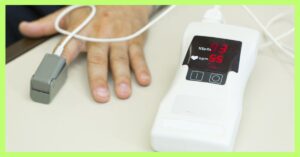
Technology is still playing an important role in revolutionising medical practises in the modern healthcare environment. The pulse oximeter is one such technological marvel that has attracted widespread attention. This simple instrument, which is frequently attached to a patient’s fingertip, is extremely important in medical diagnostics, particularly in critical care circumstances. Since the COVID-19 pandemic, pulse oximetry has grown even more important in patient monitoring, ushering in a new era of healthcare possibilities. In this essay, we will investigate the multidimensional importance of pulse oximeters in healthcare, investigating their applications in diverse medical situations and finding new advances that have increased their efficacy.
Importance of Pulse Oximetry in Medical Diagnosis
Pulse oximetry, a non-invasive way of monitoring oxygen saturation levels in the bloodstream, has changed the medical diagnostic landscape. Healthcare workers can quickly examine a patient’s oxygenation status by shining light through the skin and measuring the amount of oxygen-bound haemoglobin. This information is extremely useful in diagnosing a wide range of ailments, from respiratory disorders to cardiovascular diseases.
The Role of Pulse Oximeters in COVID-19 Patient Monitoring
In the aftermath of the COVID-19 pandemic, pulse oximeters have become critical tools for monitoring patients’ respiratory status. The virus’s proclivity to cause silent hypoxia, a condition in which oxygen levels fall dangerously low without obvious symptoms, highlights the significance of regular oxygen saturation monitoring. Pulse oximeters aid in rapid medical intervention by detecting hypoxemia early, potentially averting serious complications and saving lives.
Pulse Oximeter Applications in Critical Care

Pulse oximeters function as watchful monitors of patients’ oxygenation levels in critical care conditions. In settings ranging from acute care units to emergency rooms, these unobtrusive devices provide real-time insights about patients’ physiological status. This constant monitoring allows healthcare staff to detect episodes of oxygen deficiency immediately, allowing for swift interventions and individualised patient care.
In intensive care units and critical care settings, pulse oximeters are useful tools for continuous patient monitoring. They provide real-time data that assists medical personnel in monitoring severely ill patients’ oxygenation and cardiovascular status. Early detection of oxygen shortage may result in more prompt interventions and improved patient outcomes.
Pulse Oximeter Use During Surgeries
The application of pulse oximeters extends to the operating room, where they contribute significantly to patient safety during surgeries. Anesthesia can sometimes compromise respiratory function, making post-operative monitoring of oxygen levels crucial. By closely tracking oxygen saturation, anesthesiologists can ensure patients recover smoothly and respond promptly to any deviations from the norm.
Innovations in Hospital-Grade Pulse Oximeters
The discipline of pulse oximetry has seen amazing advancements, particularly in the creation of hospital-grade equipment. These sophisticated oximeters provide improved accuracy and usefulness, meeting the changing needs of modern healthcare. Wireless connectivity, cloud-based data storage, and integration with electronic health records have all helped to improve patient care and raise the general standard of medical practise.
Conclusion
In the ever-evolving landscape of healthcare technology, pulse oximeters stand as a testament to human ingenuity and innovation. From their pivotal role in diagnosing various medical conditions to their indispensable contribution in critical care and surgical settings, these unassuming devices have transformed patient monitoring and care. As we continue to navigate the complexities of medical diagnosis and treatment, pulse oximeters serve as unwavering allies, ensuring that each breath a patient takes is monitored and safeguarded.
FAQs
How does pulse oximetry work?
Pulse oximetry works by emitting light through the skin to measure oxygen-bound hemoglobin in the bloodstream, providing real-time oxygen saturation readings.
Can pulse oximeters be used at home?
Yes, many pulse oximeters are designed for home use, allowing individuals to monitor their oxygen levels conveniently, especially in cases of chronic respiratory conditions.
Are there any risks associated with pulse oximetry?
Pulse oximetry is generally safe and non-invasive. However, factors like poor circulation or nail polish may affect accuracy.
How frequently should COVID-19 patients use pulse oximeters?
COVID-19 patients at home or in non-critical care settings are often advised to monitor their oxygen levels multiple times a day to detect any potential drops.
Can pulse oximeters replace blood gas measurements?
While pulse oximeters provide valuable insights, blood gas measurements remain essential for a comprehensive understanding of respiratory function and acid-base balance.






